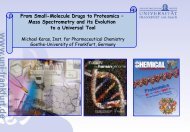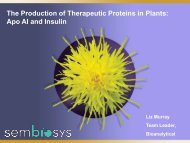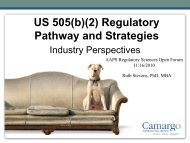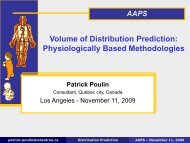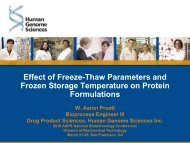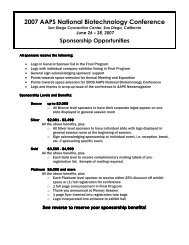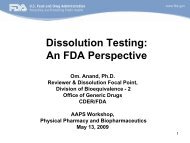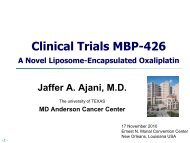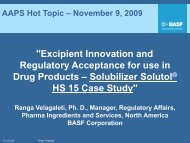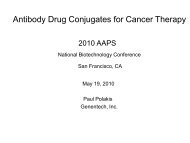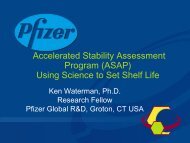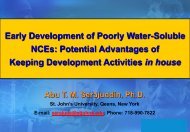Preliminary Program - American Association of Pharmaceutical ...
Preliminary Program - American Association of Pharmaceutical ...
Preliminary Program - American Association of Pharmaceutical ...
Create successful ePaper yourself
Turn your PDF publications into a flip-book with our unique Google optimized e-Paper software.
60<br />
2009 AAPS Annual Meeting and Exposition<br />
Physical Pharmacy and Biopharmaceutics (PPB) <strong>Program</strong>ming<br />
New INTERACTIVE FEATURE for all Roundtable Sessions!<br />
Click on roundtable moderator names to submit questions that you would like to be addressed at the roundtable session in Los Angeles.<br />
Sunday, November 8, 2009<br />
8:00 am – 4:00 pm<br />
Rational Design and Development <strong>of</strong><br />
Solid Dispersions with Amorphous Drug<br />
for Improving Oral Bioavailability<br />
Short Course #6<br />
An additional fee is required to attend this short course<br />
It has been estimated that over 50% <strong>of</strong> the new<br />
chemical entities (NCEs) are too insoluble for<br />
efficient oral absorption. Increasing dissolution<br />
rate and in vivo exposure <strong>of</strong> poorly soluble drugs<br />
by the use <strong>of</strong> high energy solids (e.g., amorphous<br />
state) and the application <strong>of</strong> polymer matrices for<br />
delivery purpose have been broadly employed. In<br />
recent years, there has been a large increase in the<br />
number <strong>of</strong> scientific publications and patents in<br />
this area <strong>of</strong> research. Reports in the literature have<br />
shown remarkable enhancement in dissolution<br />
rates and enhanced oral absorption <strong>of</strong> high energy<br />
solids generated by spray drying, antisolvent<br />
precipitation, and hot-melt extrusions. The advances<br />
in fundamental understanding <strong>of</strong> high energy solids<br />
as well as development <strong>of</strong> practical approaches<br />
to overcome inherent limitations with high energy<br />
solids have made the field highly attractive for<br />
pharmaceutical scientists. However, discussions on<br />
recent exploration <strong>of</strong> high energy solids and related<br />
technical challenges at national and international<br />
forums have been limited. Although some aspects<br />
<strong>of</strong> amorphous systems, solid dispersions, crystal<br />
engineering, etc., were presented in different<br />
meetings, there was no general discussion <strong>of</strong><br />
various aspects <strong>of</strong> amorphous solids in one forum.<br />
This short course will focus on all aspects <strong>of</strong> high<br />
energy, amorphous solids and related drug product<br />
development, including generating amorphous<br />
materials via different manufacturing processes,<br />
selecting polymer to stabilize the amorphous state,<br />
making appropriate formulations intended for oral<br />
administration, characterizing and understanding<br />
solid state physical stability, applying appropriate<br />
analytical methodologies, etc. All <strong>of</strong> these<br />
aspects will pr<strong>of</strong>oundly influence the scientific<br />
community <strong>of</strong> formulation scientists and analytical<br />
scientists for exploration <strong>of</strong> amorphous solids and<br />
facilitating technical breakthroughs in this field.<br />
Numerous challenges exist in consistently and<br />
reproducibly generating amorphous solid materials,<br />
characterizing <strong>of</strong> amorphous solids regarding its<br />
in vitro performance, selecting and optimizing<br />
the appropriate polymeric matrices for achieving<br />
physical stability, selecting desired manufacturing<br />
process (e.g., spray drying, hot-melt extrusion, etc.)<br />
with optimal conditions, and achieving improved in<br />
vivo exposure, and developing formulation products<br />
intended for oral use. This short course will focus on<br />
all aspects <strong>of</strong> amorphous solids towards successful<br />
oral delivery <strong>of</strong> insoluble compounds.<br />
Moderators<br />
Ping Gao, Ph.D.<br />
Abbott Laboratories<br />
Jiansheng Tang, Ph.D.<br />
Mylan <strong>Pharmaceutical</strong>s, Inc.<br />
Eric Munson, Ph.D.<br />
University <strong>of</strong> Kansas<br />
Crystallization and Stabilization <strong>of</strong><br />
Amorphous Solids<br />
Lian Yu, Ph.D.<br />
University <strong>of</strong> Wisconsin-Madison<br />
Enablement <strong>of</strong> Drug Discovery through<br />
Supersaturation and Amorphous Solids<br />
Michael J. Hageman, Ph.D.<br />
Bristol-Myers Squibb<br />
Crystallization from Amorphous Systems<br />
Lynne Taylor, Ph.D.<br />
Purdue University<br />
Assessing and Optimizing Supersaturation<br />
in Amorphous Solids and Dispersions<br />
Marcus Brewster, Ph.D.<br />
Johnson & Johnson<br />
Predicting Amorphous Drug Stability in Drug<br />
Formulations<br />
Eric Munson, Ph.D.<br />
University <strong>of</strong> Kansas<br />
Characterization <strong>of</strong> In Vitro Release Attributes<br />
<strong>of</strong> Amorphous Solids and their Relevance to<br />
In Vivo Absorption<br />
Ping Gao, Ph.D.<br />
Abbott Laboratories<br />
Turning Challenges into Opportunities:<br />
Formulation Development for Poorly Soluble<br />
Drugs — The Meltrex Approach<br />
Ulrich Westedt, Ph.D.<br />
Abbott Laboratories<br />
Enhancing Bioavailability <strong>of</strong> Low Solubility<br />
Compounds: Amorphous Dispersion Delivery<br />
Platforms<br />
David Vodak, Ph.D.<br />
Bend Research Inc.<br />
Monday, November 9, 2009<br />
MONDAY MORNING ROUNDTABLES<br />
Funded by a Grant from<br />
8:00 am – 10:00 am<br />
Optimization <strong>of</strong> Systemic Exposure in<br />
Preclinical and Clinical Development:<br />
“Success Stories” <strong>of</strong> Proven Methods for<br />
Challenging Drug Candidates — What<br />
You Did Not Already Know!<br />
Roundtable<br />
The identification and development <strong>of</strong> new drug<br />
candidates with a desirable systemic exposure<br />
that is both efficacious and safe in humans<br />
with “developable” formulations based on<br />
preclinical data remains a major challenge in the<br />
pharmaceutical sciences. One reason is that oral<br />
systemic exposure is determined by a variety <strong>of</strong><br />
physicochemical and metabolic factors including<br />
drug solubility, permeability, dissolution, dosage<br />
forms, as well as, first-pass, transporter effects,<br />
and varying gastrointestinal physiology. Another<br />
reason is that multidisciplinary teams <strong>of</strong>ten cannot<br />
reach consensus which formulation and modeling<br />
approaches can be used with confidence to select<br />
a dosage form for first in human studies. Thus,<br />
science driven strategies to determine the systemic<br />
exposure rate limits will be presented based on<br />
new compounds and new data to correct analysis<br />
<strong>of</strong> factors controlling exposure for drugs <strong>of</strong> all<br />
BCS classes. When low exposure is seen, there<br />
can be the incorrect perception that formulation<br />
improvement works for every compound. In other<br />
cases, controlled release formulations should be<br />
attempted to optimize the PK pr<strong>of</strong>iles. Modeling and<br />
simulation are also meaningful tools in designing<br />
PK/formulation/ADME/TK studies, as well as,<br />
species scaling to human. Specific formulation<br />
strategies, and proven modeling approaches that<br />
can be used when facing different BCS classification<br />
compounds will be shared. In addition, the role<br />
<strong>of</strong> transporters in drug disposition with a focus<br />
on BCS Class II-IV drugs will be discussed, as well<br />
as, science-driven optimization <strong>of</strong> formulation<br />
selection studies for clinical trials and final<br />
marketing formulations.<br />
Moderators<br />
Tycho Heimbach, Ph.D., M.S.<br />
Novartis<br />
Hyo-Kyung Han, Ph.D.<br />
Chosun University



